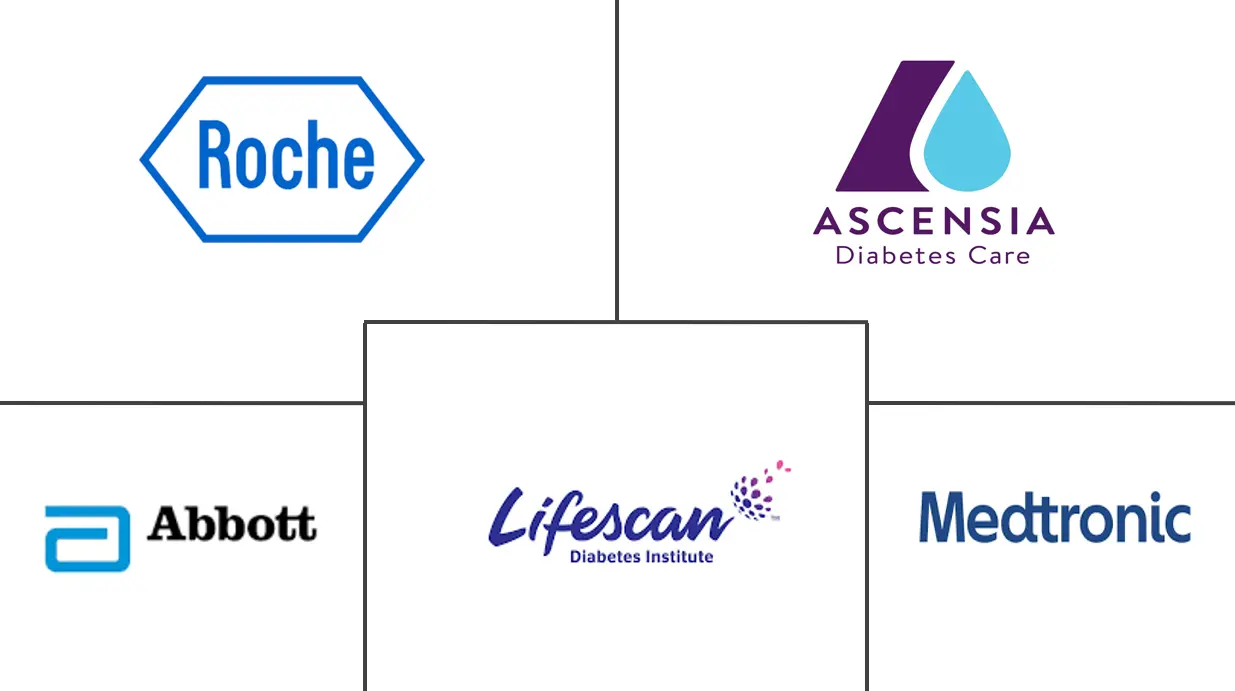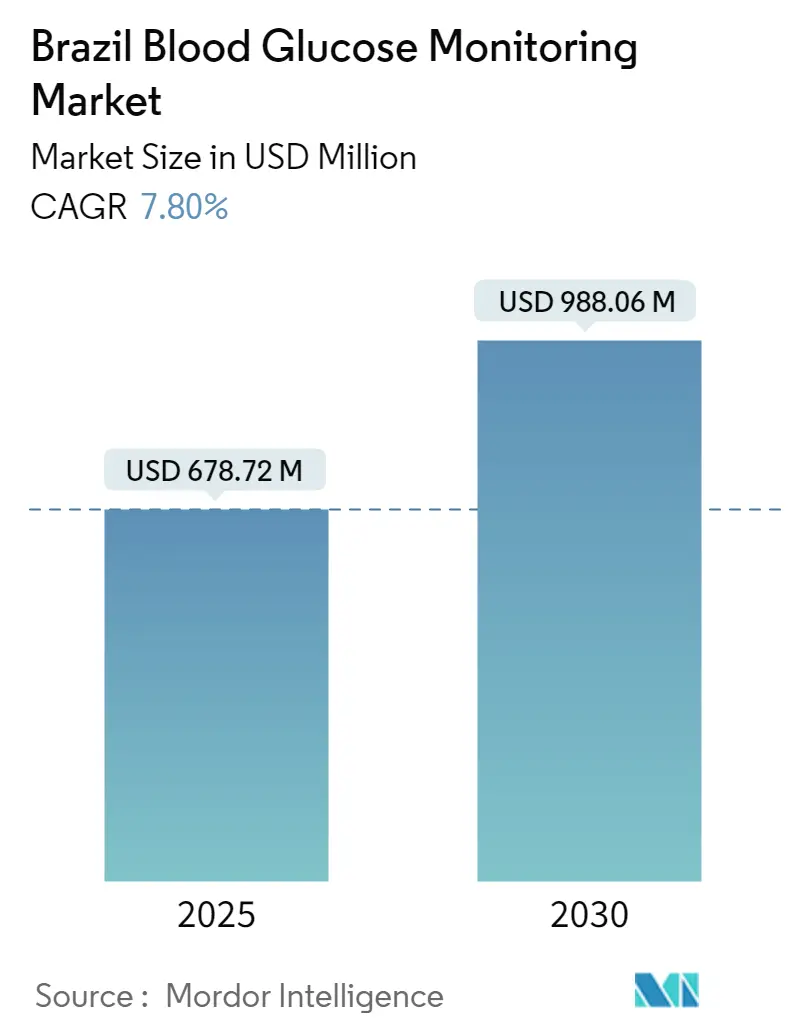
Brazil Blood Glucose Monitoring Market Analysis by Mordor Intelligence
The Brazil Blood Glucose Monitoring Market size is estimated at USD 678.72 million in 2025, and is expected to reach USD 988.06 million by 2030, at a CAGR of 7.8% during the forecast period (2025-2030).
One of the most significant risk factors for a severe course of COVID-19 is diabetes mellitus. This risk is believed to be influenced by several variables that are frequently present in diabetes mellitus, such as advanced age, a proinflammatory and hypercoagulable condition, hyperglycemia, and underlying comorbidities (hypertension, cardiovascular disease, chronic kidney disease, and obesity). Diabetes was quickly recognized as a risk factor for bad results during the COVID-19 pandemic. That's why managing or delaying diabetes became more important than ever before. Several studies have confirmed that chronic diseases like diabetes are associated with adverse outcomes in COVID-19 patients.
Diabetes is associated with many health complications. Comparing the population with and without diabetes, those with diabetes have a 300% increased risk of being hospitalized and, thus, incur more healthcare expenses compared to non-diabetic people. People with diabetes face a higher chance of experiencing serious complications from COVID-19. In general, people with diabetes are more likely to experience severe symptoms and complications when infected with a virus. Diabetes and high glucose levels are associated with increased complications, respiratory failure, and mortality in hospitalized patients with coronavirus.
Brazil has implemented a set of reforms over the past to improve the distribution of doctors, develop new forms of the service organization, introduce new financing models, and implement a range of quality improvement initiatives and policy frameworks to overcome risk factors such as obesity and emerging pandemic threats. The pandemic also highlighted opportunities for continuing and expanding innovations in the delivery of diabetes care, through virtual consultations between healthcare providers and people with diabetes, and the use of diabetes technology. Crisis management has created unprecedented interest in remote care from both patients and providers and removed many long-standing regulatory barriers. Thus, the COVID-19 outbreak increased the blood glucose monitoring market's growth.
Brazil Blood Glucose Monitoring Market Trends and Insights
Rising diabetes prevalence
Brazil's diabetes population is expected to increase with a CAGR of about 2.9% over the forecast period.
According to IDF Diabetes Atlas 2021, 15.7 million adults, about 10.5%, were living with diabetes in Brazil - or one in ten adults. The cost of diabetes-related health expenditure in Brazil is the third highest in the world, at USD 42.9 billion. In addition, 18 million adults, around 11.9%, suffer from Impaired Glucose Tolerance which places them at high risk of developing type 2 diabetes. Diabetes is associated with many health complications. Comparing the population with and without diabetes, those with diabetes include an increased risk of being hospitalized and, thus, incur more healthcare expenses than non-diabetic people. Additional data on glycaemic control in Brazil show that only 25% met the therapeutic goal of glycated hemoglobin (HbA1c) < 7% before the pandemic, as recommended by the Brazilian Diabetes Society (SBD).
The high prevalence of diabetes is associated with a significant economic burden. The costs of diabetes are increased in patients with co-morbidities such as hypertension and hyperlipidemia and in patients who develop complications. Costs increase with an increasing number of complications. The Ministry of Health established a list of medications and supplies the Brazilian Health System provides to patients suffering from diabetes. However, their supply usually needs to be increased or recommended for optimal patient management across cities. In Brazil, the public health system Sistema Único de Saúde (SUS) progressively increased the assistance available for individuals with diabetes.
Therefore, owing to the increasing diabetes prevalence and factors above, the studied market is anticipated to grow over the analysis period.
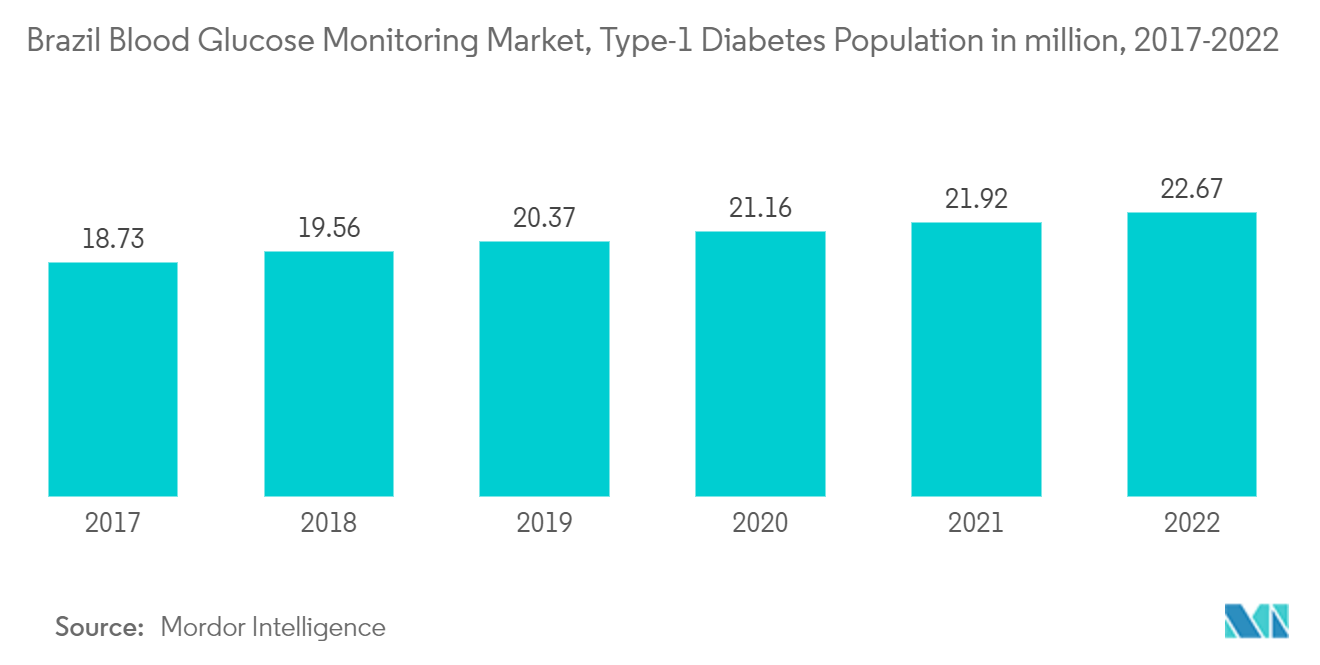
The continuous glucose monitoring segment is expected to witness the highest growth rate over the forecast period
The Continuous Glucose Monitoring Segment is expected to grow at a CAGR of about 11.9% over the forecast period.
To use a CGM, a small sensor is inserted into the abdomen or arm with a tiny plastic tube known as a cannula penetrating the top layer of skin. An adhesive patch holds the sensor in place, allowing it to take glucose readings in interstitial fluid throughout the day and night. Generally, the sensors must be replaced every 7 to 14 days. A small, reusable transmitter connected to the sensor allows the system to send real-time readings wirelessly to a monitor device that displays blood glucose data. Some systems come with a dedicated monitor, and some display the information via a smartphone app.
CGM sensors proved to be effective for patients with frequent hypoglycemic events, sensor-augmented pumps, and gestational diabetes, treated with either continuous subcutaneous insulin infusion or a multiple daily injections insulin regimen. Researchers are trying to find and develop alternatives to electrochemical-based glucose sensors and create more affordable, minimally invasive, and user-friendly CGM sensors. Optical measurement is a promising platform for glucose sensing. Some technologies with high potential in continuous glucose sensing are reported, including spectroscopy, fluorescence, holographic technology, etc. Eversense, a CGM sensor based on fluorescence sensing developed by Senseonics Company, presents a much longer lifespan than electrochemical sensors.
CGM devices must be used alongside insulin pumps. As the trends show a higher number of diabetic patients using insulin pumps for diabetes management, it can be predicted that the number of units of CGM devices sold will also follow. Type-1 patients require continuous monitoring to closely monitor their glucose levels, which will likely generate demand in the coming years. Due to the adaptability of new technology and the high prevalence of diabetes, the market studied is expected to grow.
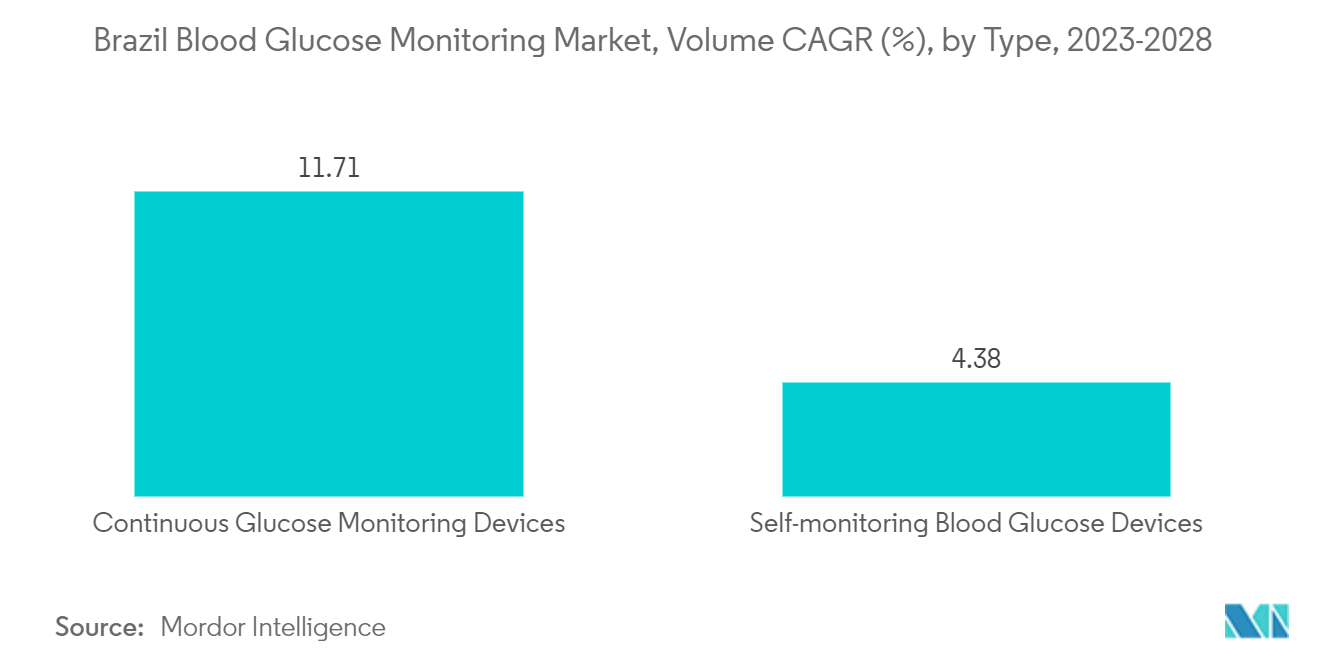
Competitive Landscape
The Brazil Blood Glucose Monitoring Market is moderately fragmented, with few significant and generic players. Constant innovations are driven by manufacturers such as Abbott and Medtronic while adhering to organic growth strategies. It is evident from the R&D spending of these companies.
Brazil Blood Glucose Monitoring Industry Leaders
Medtronic
Lifescan
Abbott Diabetes Care
Roche Diabetes Care
Ascensia Diabetes Care
- *Disclaimer: Major Players sorted in no particular order
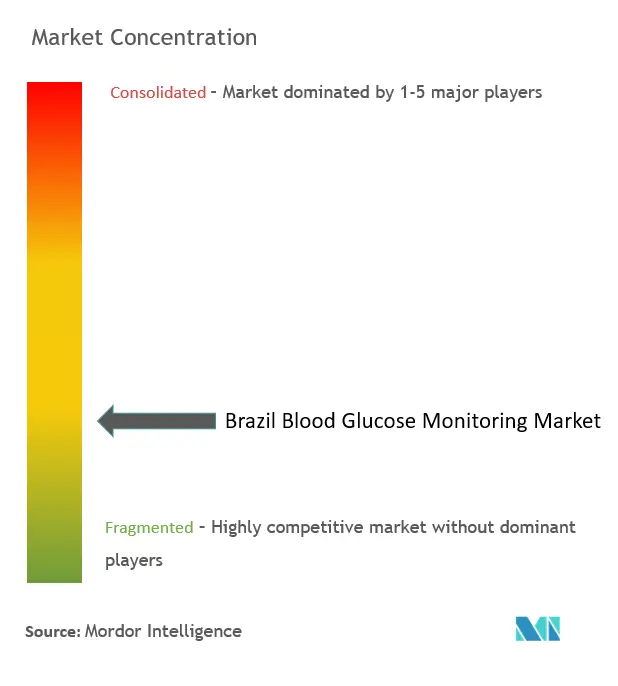
Recent Industry Developments
- August 2022: Abbott and WW International, Inc. (WeightWatchers) announced a strategic partnership to help people with diabetes better understand and manage their diabetes and weight. The companies are working to integrate WeightWatchers' diabetes-tailored weight management program with Abbott's portfolio of FreeStyle Libre products to create a seamless mobile experience. It will give people living with diabetes the information and insights needed to make healthy adjustments to their diet, improve their glucose levels, and, ultimately, gain more control of their health.
- June 2022: LifeScan announced that the peer-reviewed journal Diabetes Technology and Therapeutics published real-world evidence of improved glycemic control in people with diabetes using a Bluetooth-connected blood glucose meter with a mobile diabetes management application. It uses the OneTouch Reveal mobile app with the OneTouch Verio Reflect meter- synced via Bluetooth wireless technology that could support improved glycemic control for people with diabetes.
Brazil Blood Glucose Monitoring Market Report Scope
Blood Glucose Monitoring devices are used to diagnose both hyperglycemic and hypoglycemic conditions in diabetic patients. The Brazil Blood Glucose Monitoring Market is segmented into types (self-monitoring blood glucose devices (glucometer devices, test strips, and lancets) and continuous glucose monitoring devices (sensors and durables (receivers and transmitters))). The report offers the value (in USD million) and volume (in units million) for the above segments.
| Self-monitoring blood glucose devices | Glucometer Devices |
| Test Strips | |
| Lancets | |
| Continuous blood glucose monitoring devices | Sensors |
| Durables (Receivers and Transmitters) |
| Type | Self-monitoring blood glucose devices | Glucometer Devices |
| Test Strips | ||
| Lancets | ||
| Continuous blood glucose monitoring devices | Sensors | |
| Durables (Receivers and Transmitters) | ||
Key Questions Answered in the Report
How big is the Brazil Blood Glucose Monitoring Market?
The Brazil Blood Glucose Monitoring Market size is expected to reach USD 678.72 million in 2025 and grow at a CAGR of 7.80% to reach USD 988.06 million by 2030.
What is the current Brazil Blood Glucose Monitoring Market size?
In 2025, the Brazil Blood Glucose Monitoring Market size is expected to reach USD 678.72 million.
Who are the key players in Brazil Blood Glucose Monitoring Market?
Medtronic, Lifescan, Abbott Diabetes Care, Roche Diabetes Care and Ascensia Diabetes Care are the major companies operating in the Brazil Blood Glucose Monitoring Market.
What years does this Brazil Blood Glucose Monitoring Market cover, and what was the market size in 2024?
In 2024, the Brazil Blood Glucose Monitoring Market size was estimated at USD 625.78 million. The report covers the Brazil Blood Glucose Monitoring Market historical market size for years: 2019, 2020, 2021, 2022, 2023 and 2024. The report also forecasts the Brazil Blood Glucose Monitoring Market size for years: 2025, 2026, 2027, 2028, 2029 and 2030.
Page last updated on:
Brazil Blood Glucose Monitoring Market Report
Statistics for the 2025 Brazil Blood Glucose Monitoring market share, size and revenue growth rate, created by Mordor Intelligence™ Industry Reports. Brazil Blood Glucose Monitoring analysis includes a market forecast outlook for 2025 to 2030 and historical overview. Get a sample of this industry analysis as a free report PDF download.
